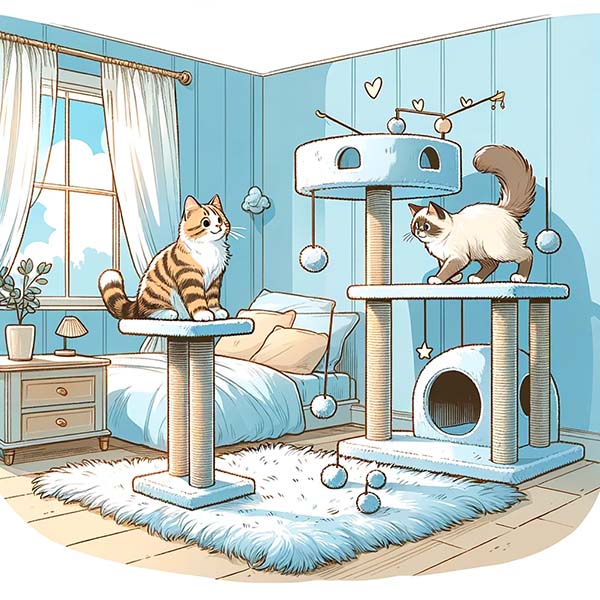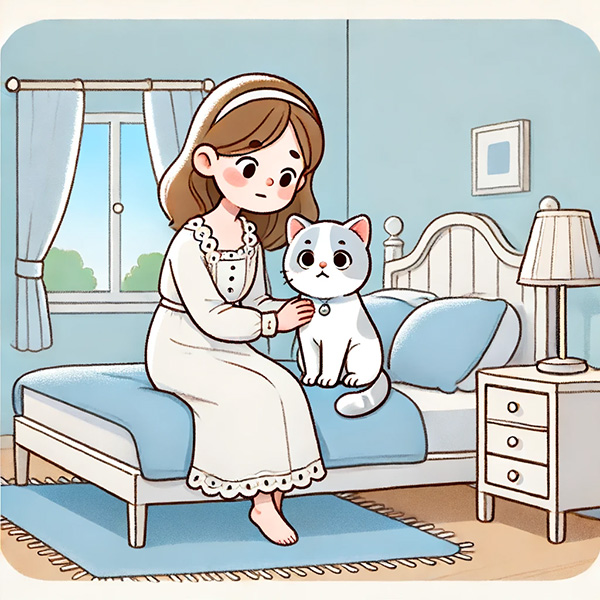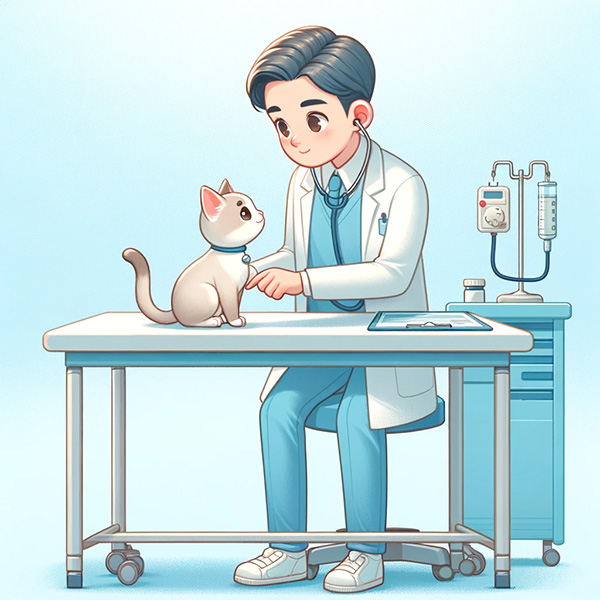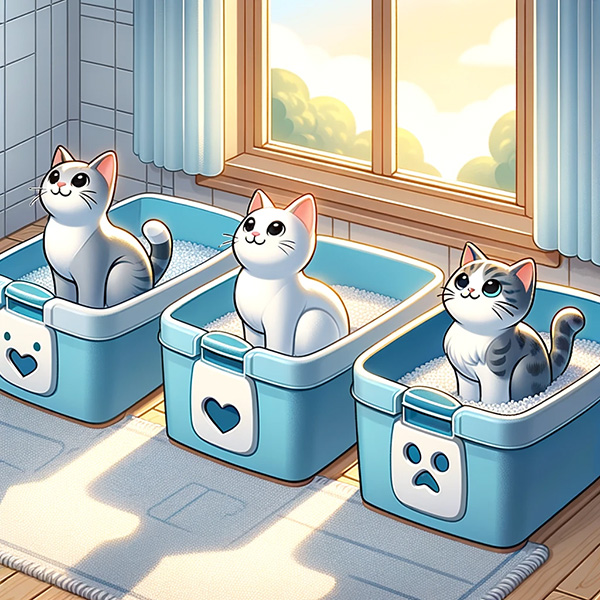Acknowledging and alleviating stress in our feline companions is paramount for their well-being. Cats, similar to humans, undergo stress, which can profoundly influence their health and behavior. Various factors, from environmental changes to routine disruptions, can make a cat anxious or stressed. As responsible pet owners, understanding the signs of stress and the cat's body language and knowing how to address them effectively is essential.
In this blog post, we will dive into why pet cats experience stress, the symptoms to watch for, and various strategies to help soothe and reassure your stressed cat. Whether it’s through environmental enrichment, maintaining a routine, or using calming products, there are many ways to help your cat feel more secure and content in their daily life.
8 Ways To Relieve Stressed Cat
Environmental Enrichment

Environmental enrichment is a key strategy for alleviating stress in cats. Engaging their natural instincts and behaviors enhances their quality of life. Cats are inherently curious and territorial creatures, and a stimulating environment can prevent many stress-related issues by keeping them engaged and satisfied.
Introduce elements that cater to a cat's need for physical exercise and mental stimulation to create an enriched environment. This includes installing cat trees and shelves that allow them to climb and explore vertically, mimicking their natural outdoor behavior. Scratching posts satisfy their natural urge to scratch while also allowing them to stretch and mark their territory securely within your home.
Interactive toys and puzzle feeders play a critical role in mental stimulation. They encourage your cat to think and solve problems, which can distract them from stressors. Additionally, providing window perches helps them stay connected to the outside world, satisfying their curiosity and keeping boredom at bay.
If you have access to a safe outdoor area, you might want to consider a catio—a secure outdoor enclosure that allows your indoor cats to enjoy the outdoors without the dangers of unrestricted roaming. If a catio is not an option, you can let your cat roam in the backyard or the neighborhood. To keep intruders out, it's crucial to create a cat-exclusive entry point to your home door, such as a microchip-activated cat flap. Offering fresh air and stimulating the natural world can significantly enhance their environment and reduce stress.
Routine Maintenance

Maintaining a consistent routine is crucial in reducing stress and enhancing cats' well-being. Cats thrive in predictable environments that offer them a sense of security and control, as they are creatures of habit. Sudden changes in their daily schedule, such as feeding times, play sessions, and even sleeping arrangements, can lead to anxiety and stress.
Establish a regular routine that includes specific meal times, play, and rest to support your cat's need for stability. Feeding your cat simultaneously daily helps regulate its internal clock and reduces anxiety around mealtime. Similarly, scheduled playtime ensures regular activity, strengthens your bond, and provides mental stimulation, keeping stress at bay.
Creating a peaceful, undisturbed sleeping area also helps your cat feel safe and secure. This should be a quiet spot where they can retreat without being disturbed, further reducing stress. Embedding such predictable patterns into your cat's life can help mitigate stress-related behaviors and promote a calm, content demeanor.
Safe Spaces

Creating a safe space is vital to alleviate stress in cats, especially in a multi-cat household. This approach provides an environment where cats can feel secure and undisturbed, allowing them to retreat whenever they feel overwhelmed or anxious. Cats, as naturally territorial animals, benefit greatly from having a designated area they can claim as their own and where they are free from the intrusion of humans or other pets.
To establish such a space, pinpoint a quiet corner or room in your house that experiences less foot traffic. Equip this area with a comfortable cat bed, a scratching post, and some of their favorite toys. Making sure this space has hiding spots, such as boxes or enclosed cat beds, can also help, as cats often feel safer in enclosed spaces. If possible, add a perch or cat tree near a window where your cat can observe the outside safely, which can be incredibly soothing and mentally stimulating.
Also, take into account the overall atmosphere of the area. Ensure it’s away from loud noises and has a calming atmosphere. You might even add a pheromone diffuser to enhance the area's calming effect. By providing such a safe haven, you reduce your cat’s stress levels and contribute to their overall sense of well-being and security.
Pheromones and Calming Products

Pheromones and calming products can be highly effective tools for managing cat stress. These products mimic cats' natural pheromones to communicate comfort and safety, helping to soothe and calm anxious behaviors. Products like Feliway, a popular synthetic pheromone diffuser, release a scent that is imperceptible to humans but immensely comforting to cats, creating a sense of security in their environment.
To utilize these products efficiently, position pheromone diffusers in locations where your cat typically spends the most time or within a designated safe area to amplify the calming effect. These can be particularly useful in multi-cat households to ease tensions or in any situation that disrupts your cat’s routine, such as moving to a new home or introducing a new pet.
Calming collars infused with pheromones can also be used, especially for cats that might benefit from a continuous release of calming signals. These are useful for cats that need to adjust to frequently changing environments or for visits to the vet. Remember, while these products can significantly reduce stress, they work best when combined with a stable routine and a supportive environment tailored to your cat’s needs.
Handling and Interaction

Proper handling and interaction are essential techniques for relieving stress in cats, and understanding your cat's preferences is key. Many cats are diverse in their tolerance for physical interaction; some may crave frequent cuddles, while other cats prefer minimal contact. Observing and respecting these preferences is crucial to ensuring your cat feels secure and not threatened, which can significantly reduce stress.
To effectively manage and reduce stress through handling, always approach your cat calmly and non-threateningly. Let your cat initiate contact and avoid forcing interactions, which can increase anxiety. When your cat does seek attention, respond with gentle strokes or scratches in their preferred spots—commonly the base of the ears, under the chin, or along the cheeks. These areas contain scent glands, which, when stimulated, help your cat feel more relaxed and content.
Incorporating regular, positive interactions into your daily routine can also help build trust and a sense of safety. Play sessions, using toys that allow your cat to exhibit natural hunting behaviors, not only reduce stress but also strengthen your bond. Remember, the goal is to create a consistent and reassuring environment where your cat feels loved and secure.
Health Checks

Regular health checks are a fundamental part of managing and alleviating stress in cats while keeping your cat healthy. Often, the signs of stress in cats—such as changes in eating habits, grooming, or litter box usage—can mimic or mask underlying health issues. By ensuring your cat undergoes periodic veterinary exams, you can catch and address health problems early before they cause significant discomfort or increase stress levels.
During these check-ups, veterinarians can assess your cat for common stress-related health issues, such as urinary tract infections, skin disorders, or gastrointestinal problems, which are often exacerbated by stress. They can also offer advice on dietary adjustments, exercise routines, and environmental modifications to aid in stress reduction.
Additionally, understanding your cat’s health status can guide you in adjusting your approach to their care and interaction, allowing you to tailor your support to their specific needs. For example, a cat with arthritis may require gentle handling and easy access to all necessities to minimize discomfort and stress. Regular health checks ensure not only your cat's physical well-being but also their emotional health, helping to maintain a calm, stress-free environment.
Behavioral Training

Behavioral training is an effective method for relieving stress in cats by fostering a sense of security and control. This approach involves teaching your cat to associate potentially stressful situations with positive outcomes, thereby reducing anxiety and enhancing their ability to cope with environmental changes.
Begin with fundamental commands or cues to help your cat feel more comfortable. For example, training your cat to respond to a cue for "safe space" can guide them to a designated calm area when they feel overwhelmed. Use a few treats and gentle praise to reinforce these behaviors, ensuring the training sessions are short, positive, and consistent.
Clicker training is another effective technique that utilizes a sound—a click—to pinpoint the precise moment when your cat performs a desired behavior, followed by a reward. This method is particularly effective in helping your cat learn new behaviors quickly and with less stress.
Introducing puzzle toys during training sessions can also engage your cat's mind, reduce boredom, and help them focus on tasks that divert their attention from stressors. Overall, behavioral training not only addresses specific stress triggers but also enhances your overall relationship with your cat by improving communication and trust.
Appropriate Number of Clean Litter Boxes

Maintaining the right number of clean litter boxes relieves cat stress. Inadequate or unclean litter boxes can lead to stress-related behaviors such as inappropriate elimination, often a sign of discomfort or anxiety. As a general guideline, it's recommended to have one more litter box than the number of cats in the household. For example, if you have two cats, you should ideally maintain three litter boxes.
Position each litter box in a quiet and easily accessible spot, away from busy areas and noisy appliances that may startle your cat. Some cats like their litter box in an enclosed container with a cat flap, while others like to have it open in a private area.
Regular cleaning of the cat litter box is also essential—scoop the boxes daily and change the litter completely on a regular basis to keep them fresh and inviting. This promotes good hygiene and makes the litter box a stress-free spot for your cat to use.
By providing multiple well-maintained litter boxes, you help minimize territorial disputes and ensure that each cat has a space of its own. Implementing this simple measure can notably diminish stress and foster a more tranquil, content environment for your feline companions.
